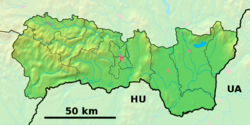Luník IX
Luník IX | |
|---|---|
Borough | |
 Luník IX in December 2020 | |
 Location within Košice | |
| Coordinates: 48°41′45″N 21°13′25″E / 48.69583°N 21.22361°E | |
| Country | Slovakia |
| Region | Košice |
| District | Košice II |
| Housing estate | 1979 |
| Area | |
• Total | 1.07 km2 (0.41 sq mi) |
| Elevation | 244 m (801 ft) |
| Population (December 2017) | |
• Total | 6,411 |
| • Density | 6,000/km2 (16,000/sq mi) |
| Population by ethnicity (2011) | |
| • Roma | 56.6% |
| • Slovak | 32.6% |
| • Hungarian | 1.2% |
| • Other | 0.2% |
| • Unreported | 9.4% |
| Population by religion (2011) | |
| • Roman Catholic | 63.4% |
| • Assemblies of God | 10.6% |
| • Old Catholic | 1.8% |
| • Greek Catholic | 1.4% |
| • Lutheran | 1.3% |
| • Other | 3.1% |
| • Non-religious | 2.2% |
| • Unreported | 16.2% |
| Postal code | 040 11 |
| Area code | +421-55 |
| Car plate | KE |
| Source [3] | |
Luník IX is a borough (city ward) in the city of Košice, Slovakia, in the Košice II district. It is located in the western-central part of the city, surrounded by the boroughs of Pereš, Myslava, Barca, Juh and Západ.
Characteristics
| City | Population |
|---|---|
| Jarovnice | |
| Luník IX | |
| Rakúsy |
Luník IX houses one of the largest communities of Romani people in Slovakia. Although originally built for 2,500 inhabitants, it is estimated that the population is now three times larger. Living standards are low, with services such as gas, water, and electricity cut off, as the majority of inhabitants are not paying rent or utilities fees and the utilities infrastructure has been ransacked to sell for scrap.[5]
Health standards are low, and diseases such as hepatitis, head lice, diarrhea, scabies and meningitis are common.[5] Unemployment in the borough reaches almost 100 percent.[5] It has one elementary school and a kindergarten.[6]
Luník IX is serviced by a bus line, which stops only on selected bus stops. Boarding the bus is only allowed through the front door. Due to frequent attacks of aggressive residents, bus drivers deployed on the line receive a hazard pay.[7]
History
The Romani village close to the borough was demolished in 1979 and the Romani people were moved into Luník IX; in addition, there was a landfill nearby. As early as in the 1980s the Romani comprised half of the population, which was around 2,000.[6] Over time, the non-Romani population gradually moved away, with the Romani taking flats after their departure, and the borough turned into a Romani ghetto.[8]
In 1995, the city council of Košice created a plan for the living conditions of dodgers[clarify], the maladjusted, and people from illegally occupied flats around Košice.[6] They were to be moved into Luník IX, with "non-problematic" families being gradually moved out if they requested it. The realization of this plan is on-going.[6]
In September 2021, Pope Francis visited the settlement and delivered an address to the inhabitants during his first papal trip to Slovakia.[9][10]
Statistics
- Area: 1.07 square kilometres (0.41 sq mi)
- Population: 6,411 (December 2017)
- Density of population: 6,000/km² (December 2017)
- District: Košice II
- Mayor: Marcel Šaňa (as of 2018 elections)
Gallery
-
Housing estate in the Luník IX borough seen from the surrounding area
-
One of the houses during papal visit (2021)
-
Situation in October 2000
References
- ^ SODB - Košice-Luník IX, 2011
- ^ SODB - Košice-Luník IX, 2011
- ^ Mestská a obecná štatistika SR Archived 2007-04-27 at the Wayback Machine
- ^ "Slovakia 2021 census: Population by ethnicity". www.scitanie.sk. Feb 2022. Retrieved 2022-02-22.
- ^ a b c "Residents of Roma ghetto to be moved". The Slovak Spectator.
- ^ a b c d "Cassovia.sk ::". www.cassovia.sk. Retrieved 14 March 2018.
- ^ a.s., Petit Press. "Lunik IX chce častejšiu mestskú dopravu". Retrieved 14 March 2018.
- ^ a.s., Petit Press. "Doctor struggles to understand Roma ghetto after 25 years". Retrieved 14 March 2018.
- ^ Muller, Robert (2021-09-08). "Seeking change, Slovak Roma settlement puts faith in Pope visit". Reuters. Retrieved 2022-02-07.
- ^ Muller, Robert (2021-09-14). "Pope calls out prejudice as he meets Roma in Slovakia". Reuters. Retrieved 2022-02-07.






